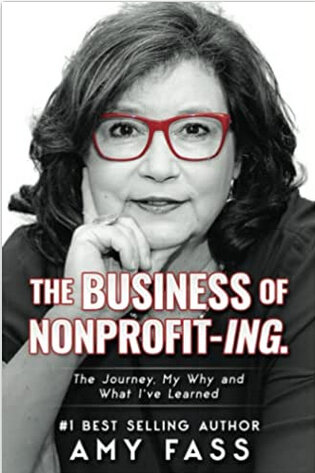The Business of Nonprofit-ing
Oftentimes, the best way to get up to speed on any task is to sit down and have a heart-to-heart with a person who does it every day. Amy Fass’s book, The Business of Nonprofit-ing, gives the reader just that kind of experience. Rather than overload the book with theory, jargon, or academic discourse, Fass, who has worked in nonprofit development and management for 25 years and currently serves as CEO and executive director of Shoes That Fit, gives the reader a basic understanding of the real world of nonprofits. Her stated goal is to give readers a sense of “the role of nonprofits, letting you know that you are not alone, and sharing some of the lessons I have learned with those who may be in similar shoes….”
At just over 100 pages, the book is a quick and easy read. Fass opens her book with an overview of her nonprofit career: After majoring in music at Stanford University, she spent a few years in college ministry, went to seminary, then pivoted to higher education and landed a job as director of corporate and foundation relations at Pomona College with no development experience, having “made a persuasive case out of nothing.” She goes on to outline her role with Shoes That Fit, a nonprofit focused on an often-overlooked issue: the lack of adequate shoes among children in poverty. The organization’s mission is to tackle one of the most visible signs of poverty in America by giving children in need new athletic shoes so they can attend school with dignity and joy, prepared to learn, play, and thrive. Fass’s skill at making her nonprofit’s case is evident in her stories on how students benefit from her nonprofit’s work. She shares key statistics on how shoes are often sacrificed by families in poverty for more basic expenses like food and couples those statistics with clear indicators of the success of the program: “87% of teachers reported improvement in self-esteem among the children who received new shoes.” She also shares some heartbreaking stories:
I saw a little girl sitting to the side, hugging her shoebox. The other kids were trying on their shoes, showing each other and running around, but she did not budge. [Her teacher and I] asked if she liked her shoes and wanted help trying them on. She shook her head and said quietly, “I’ve never had a new box like this.”
The following chapters take the reader step by step through the various elements of running a typical nonprofit and what the world gets wrong about nonprofits, what they are, how they are funded, and who runs them. Drawing on her own experience as a fundraiser and nonprofit executive, Fass debunks myths and makes every principle and bit of advice concrete and easy to understand. She underlines that “running a nonprofit IS running a business—but you are running more than just a business.” In other words, you must create a healthy financial situation while at the same time creating a social benefit. She also takes issue with the myth that low overhead guarantees an efficient nonprofit: “You need to invest in employees, the front-line of your work, and compensate them fairly. As flight attendants say, you have to put on your mask first if you are going to take care of others.”
Her discussion of nonprofit self-sufficiency as another myth leads into her chapter on funding and fundraising, which dispels many other misunderstandings, including the supposed “unseemliness” of asking for money and the misguided reliance on “windfalls” or surprise gifts. As she states in her “foundational principles” list, “fundraising starts with strategy…and strategy starts with a crystal-clear articulation of what you are trying to achieve and why…. It’s much more compelling to show people what their support will accomplish than to ask them to ‘fill a deficit in our budget.’” Fass’s advice consistently returns to the importance of clarity, of being transparent, and of seeking to strengthen trusting relationships with donors, board members, and staff: “Engaging in relationships can be a struggle for people who are moving quickly and have a strong entrepreneurial make-up. It can be hard to slow down and bring people along with you.” However, a successful nonprofit cannot be built without such relationships.
The final chapters of the book go beyond the basics to talk about planning for the future—but Fass is careful to see the problems of planning while adapting to a changing world. In this, she provides some great suggestions to those nonprofits for which adaptation to restrictions brought on by the COVID-19 pandemic (among other issues) was an unexpected necessity: “the opportunities we need to grab [when the unexpected happens] change too rapidly to be led by a series of action steps that were determined years, or even months, ago.” Fass argues against the static strategic plan in favor of a “strategic framework,” building on a Stanford Social Innovation Review article advocating “adaptive strategy.” She further clarifies this by discussing how “culture eats strategy for breakfast,” that is, how strategic planning of any kind must also consider the culture of the organization; change is difficult for most people, and any change to office culture must be based on asking questions of the staff, developing a solid vision and celebrating small victories. Fass devotes a chapter and a postscript to addressing how to navigate crisis situations—a drop in funding, an unhappy volunteer, a disgruntled employee, or a PR debacle—or even a pandemic: clearly define the situation, share bad news honestly and completely, and breathe.
Early in the book, Fass compares running a nonprofit to feeling “like you are in a little boat in a big ocean.” And it’s fitting that she summarizes her insights and advice in a final chapter called “The Seven C’s.” These highlight the most vital components of what enables organizational growth and success: culture, clarity, connection, communication, cash, chance, and change. In fact, this summary is so perfect that this reviewer wished it were placed earlier in the book, so that the reader would know to look for each concept through the chapters.
If you are looking for a book full of cutting-edge theory, this is not that book. But those of you looking for one that quickly teaches how a nonprofit works and provides you with a sense that you are not alone in the middle of the big nonprofit ocean, then this book is definitely for you.
David M. Holmes is Programs Manager, Midwest, at Candid.







